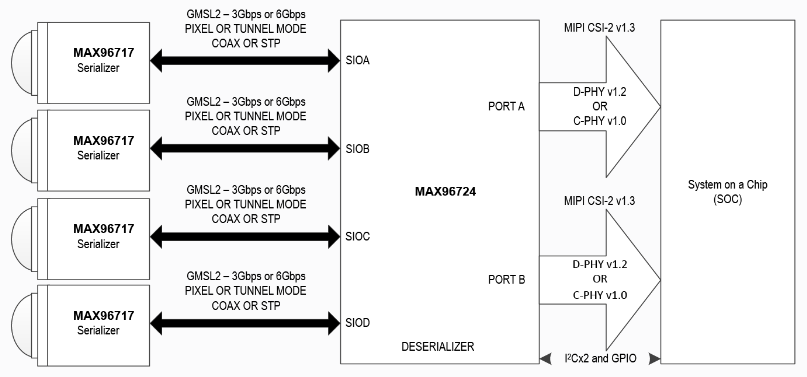
- Analog Devices, Inc.
- NEXT Mobility
1. Background
While automotive cameras traditionally had resolutions around 1 to 2 megapixels, recent rapid advancements in ADAS (Advanced Driver Assistance Systems) have created a demand for higher pixel counts in sensing cameras. Figure 1
GMSL from ADI (formerly MAXIM) is already widely used for high-speed video data transmission in vehicles.
While GMSL supported video up to 2 MP resolution, the newly released GMSL2 enables handling video data from higher-resolution cameras.
This page explains the features of ADI's (formerly MAXIM) next-generation GMSL, GMSL2.
2.MAX96717 CSI-2 to GMSL2 Serializer
One key component is the MAX96717, a second-generation GMSL serializer capable of achieving communication speeds up to 6Gbps. It serially transmits data received via its MIPI CSI-2 (4-lane D-PHY) input over the GMSL line using either STP or COAX cable.
The device comes in a 5x5mm TQFN package (see left figure).
As an application example, four camera modules equipped with the MAX96717 can be combined with the MAX96724 Quad Port GMSL2 Deserializer. (see right figure)
MAX96717 CSI-2 to GMSL2 Serializer Features
- Forward channel 3Gbps or 6Gbps, reverse channel 187.5Mbps
- 4-lane MIPI CSI-2 v1.3 input port
- MIPI D-PHY v1.2 receiver
- Automotive qualified, ASIL-B compliant
- I2C / UART, pass-through I2C/UART, SPI, GPIO, and register-programmable GPIO
- End-to-end data integrity via CRC (tunneling mode)
- Crystal-free operation using RoR (Reference over Reverse) clock
- 32-Pin (5mm x 5mm) TQFN Side-Wettable Package, 0.5mm pitch
MAX96724 Quad Tunneling GMSL2 / 1 to CSI-2 Deserializer Features
- Quad GMSL inputs, individually configurable
- Link rate: 6 / 3Gbps (GMSL2) and 3.12Gbps (GMSL1)
- Reverse link rate: 187.5Mbps / 1Mbps (GMSL2 / 1)
- Supports mixing GMSL2 / 1 pixel input and tunnel input
- 2x4 or 4x2 lane MIPI CSI-2 v1.3 output
- C-PHY v1.0 rated (5.7Gbps / lane)
- Supports DPHY v1.2 at 2.5Gbps / lane
- Automotive qualified, ASIL-B compliant (MAX96724 / F)
- I2C ports x 2: up to 1Mbps, configurable GPIO x 9
- Reference-over-Reverse (RoR) clocking
- Small TQFN package (8 x 8mm, standard and side-wettable)
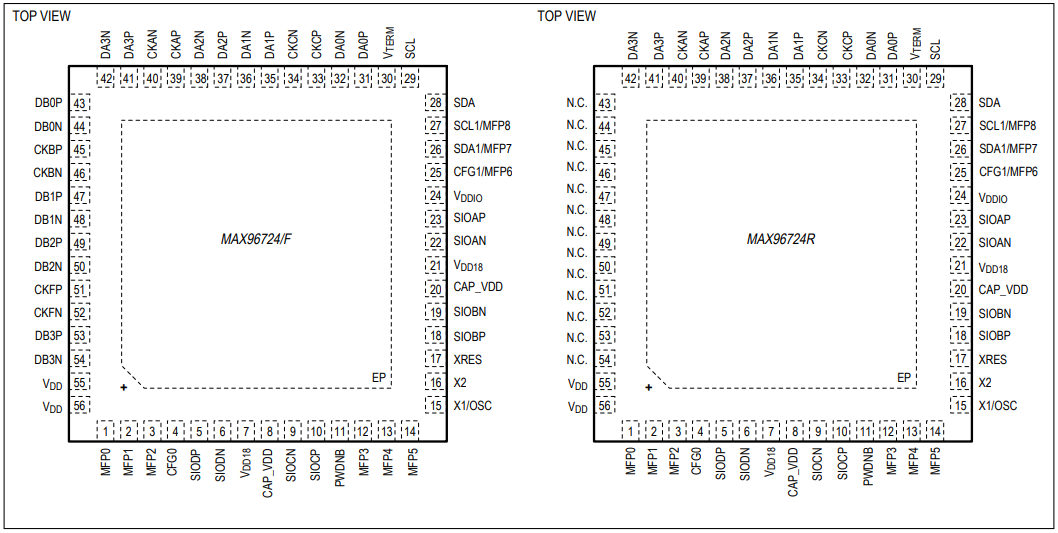
3. Key points of GMSL2 design
The hardware design points are fundamentally the same for the MAX96717 and other GMSL2 products. The following sections (a) through (e) provide an overview. Please consult the documentation for detailed information.
(a) Bandwidth Calculation
The MAX96717 GMSL2 serial transmission line supports speeds up to 6 Gbps.
It is important to ensure that the data intended for transmission does not exceed this rate.
For instance, consider the case of transmitting image data.
- 1920 × 1080 pixel
- YUV422 8bit
- Frame rate 60Hz
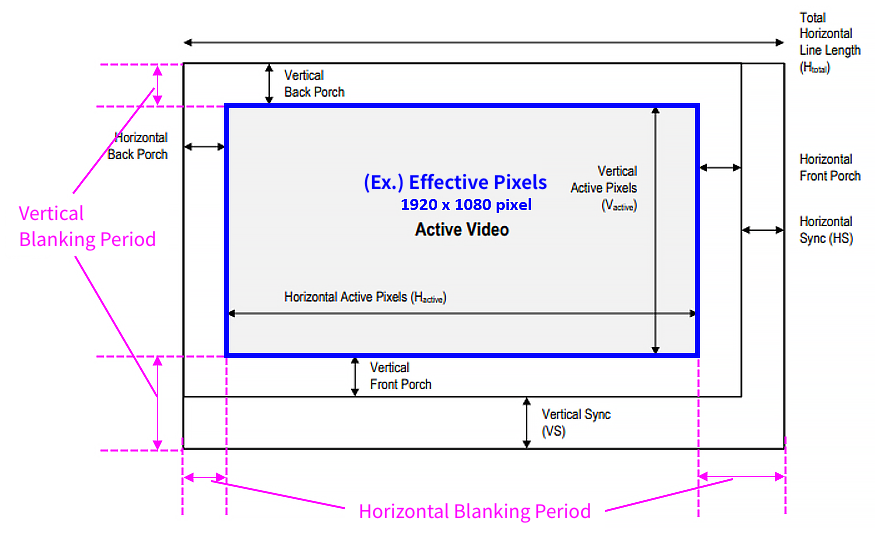
General video signals include horizontal and vertical blanking periods in addition to effective pixels. Although the blanking periods do not contain valid display image information, they are transmitted as data and must therefore be included in bandwidth calculations. The total data, including blanking periods, is generally about 1.2 times the effective pixel data.
Calculate PCLK (pixel clock) using the following formula.

PCLK = 1920 × 1080 × 1.2 × 60 = 149.3MHz
The bandwidth of the video to be transmitted is calculated with the following formula.

Video Bandwidth = 149.3MHz × 8bit = 1.19Gbps
Since 1.19 Gbps is less than 6 Gbps, transmission via GMSL2 is possible. However, actual GMSL2 communication involves transmitting various types of data alongside video data. Consequently, the bandwidth available specifically for video data is less than the full 6Gbps. Please check the user guide for details.
(b) GMSL Transmission Line Design Precautions
Designing the GMSL transmission line requires caution because it operates at high speeds up to 6Gbps.
The following design precautions apply when using COAX cable:
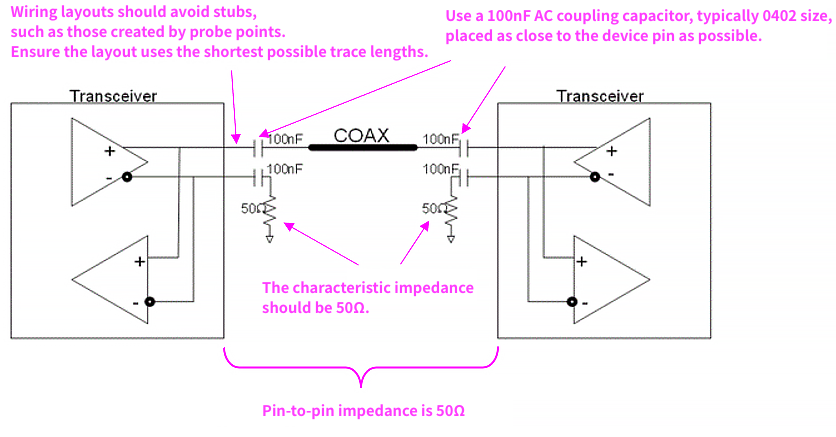
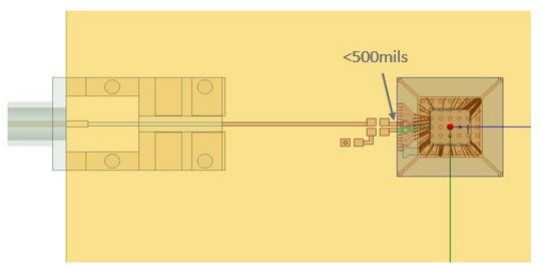
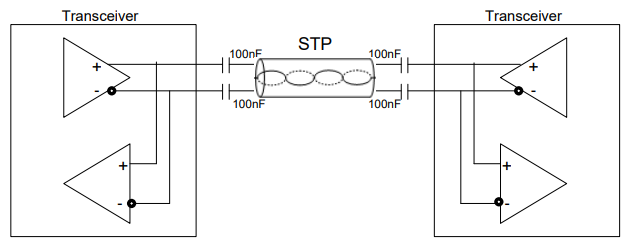
(c)Line Fault
Line Fault is a function to detect abnormalities in the GMSL transmission line. Note that the Line Fault function cannot be used simultaneously with Power Over Coax (POC), which is discussed later. By connecting voltage-dividing resistors between the GMSL line and the LMNx terminal and GND, the following abnormal states are detected.
- Short to battery
- Short to GND
- Open line
- Line-to-line short


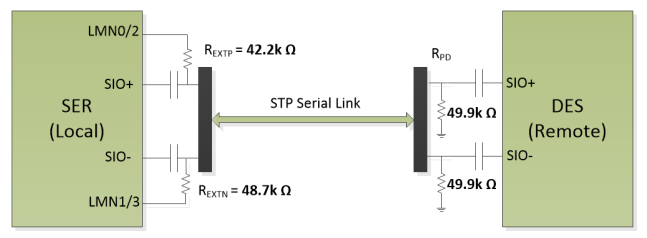
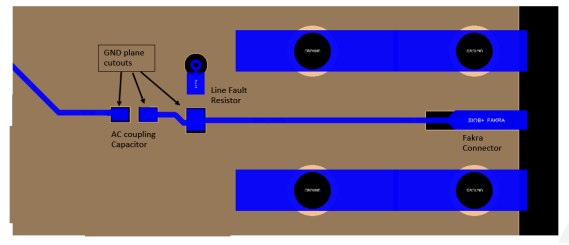
(d)POC(Power Over Coax)
Power over Coax (POC) is a technology that allows power to be superimposed onto the COAX cable along with the data signal. For example, in applications like small camera modules where size constraints make it difficult to include a dedicated power IC, power can be supplied from the deserializer side over the COAX cable and received by the serializer side within the camera module. Although high-speed communication and power share the same COAX cable, they do not interfere with each other because a POC filter is used to separate their respective frequency bands.

The POC filter uses inductors and resistors. The filter component values are chosen to effectively separate the low-frequency band used for power transmission from the high-frequency band used for the forward and reverse communication channels. The image is as shown below.
(e) ESD Protection Element
The GMSL line has an ESD protection device built into the IC. If this internal protection is insufficient for the application's requirements, an external TVS diode should be added. The characteristics required for an external TVS diode are shown below.
- Capacitance of < 0.5pF or less to, prevent degradation of high-speed GMSL2 signal
- Small package footprint lo minimize capacitance
- Low breakdown voltage and low clamping voltage
- Unidirectional, reverse-biased onto, the link
- Two-port component to minimize lane-lane crosstalk
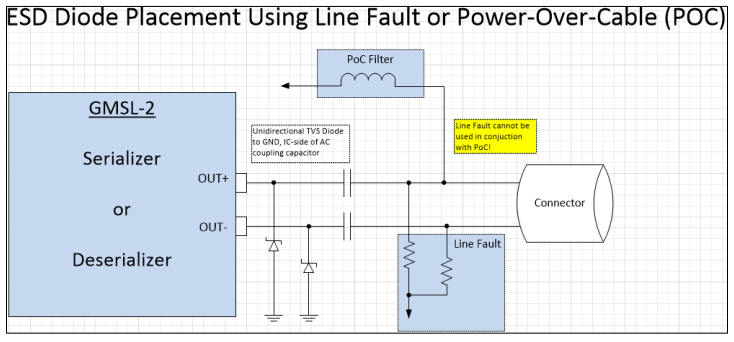
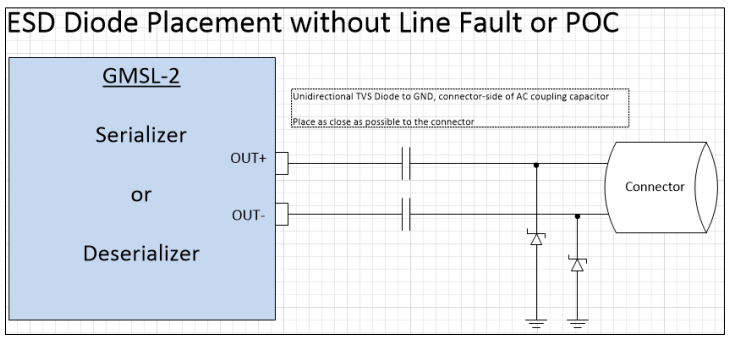
4. About Channel Specifications
The GMSL communication line operates at extremely high speeds. Failure to consider its characteristics can lead to signal attenuation and reflection, hindering proper signal reception at the receiver. Fundamentally, the GMSL transmission line is considered compliant with specifications if it meets the following channel requirements (a) through (c). Therefore, even when incorporating the previously described Line Fault, POC, or ESD protection elements, the design must still adhere to these channel specifications. Please consult the documentation for detailed information.
(a) Satisfy insertion loss and return loss channel specifications for the pin-to-pin configuration.
The pin-to-pin path extends from the Serializer's GMSL output pin, through the PCB wiring, connectors, and cable, arriving at the deserializer's GMSL input pin.

Specifically, the insertion loss must remain within negative 19.5 dB at 1.5 GHz for 3 Gbps operation, and within negative 21 dB at 3 GHz for 6Gbps operation. These specifications should ultimately be confirmed through testing on the actual device.
| GMSL2 MAXIMUM CHANNEL INSERTION LOSS PIN-TO-PIN | ||
|---|---|---|
| GMSL2 MAXIMUM CHANNEL INSERTION LOSS PIN-TO-PIN | 6 Gbps Forward ⁄ 187 Mbps Reverse | |
| APPLIED BAND | 2 MHzto 2GHz | 2 MHz to 3.5 GHz |
| INSERTEON LOSS | -19.5 dB at 1.5 GHz | -21 dB at 3 GHz |
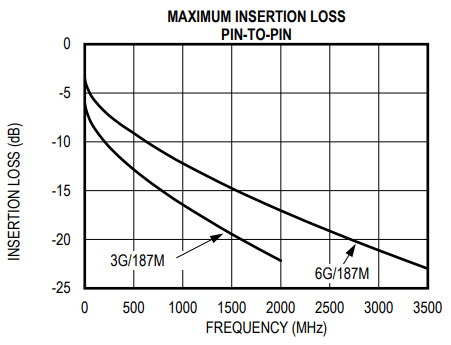
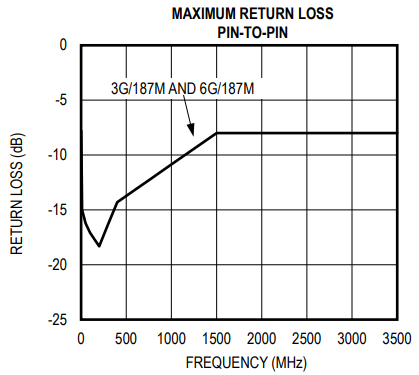
(b) Satisfy crosstalk specifications (if another high-speed transmission line is nearby).
Broadband crosstalk specifications are below: Satisfy 4 mV (p-p) from 1 to 4 GHz.
| FORWARD DATA RATE [GB ⁄ S] | REVERSE DATA RATE [MB ⁄ S] | MEASUREMENT FREQUENCY RANGE [MHz] | MAXIMUM CROSSTALK | CONDITIONS |
| 3 Gbps or 6 Gbps | 187.5 Mbps | 1 MHz to 4000 MHz | <4 mV(p-p) | Interferers are any combination of high-speed links |
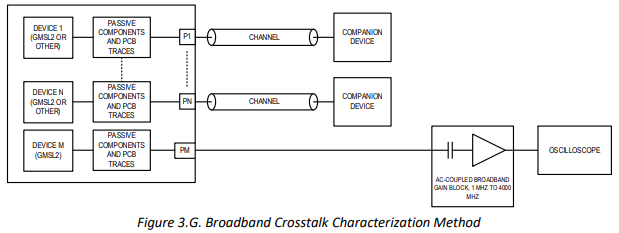
Narrowband crosstalk specifications are below:
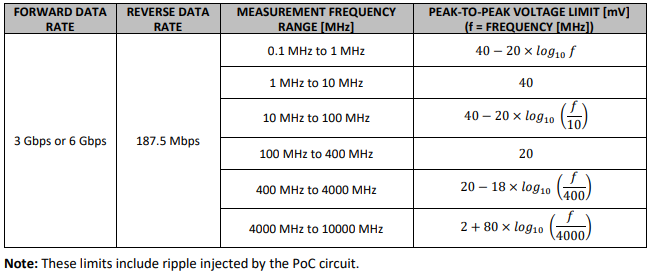
(c) Satisfy link margin specifications.
Gradually decrease the transmission amplitude from the initial value and check the amplitude margin until reception errors occur. An amplitude margin greater than the minimum required value in the table below is required (link margin = initial amplitude - amplitude just before a reception error occurs).
Tools are available for this verification, so please contact us for more information.
| CABLE | DATA RATE (FORWARD ⁄ REVERSE) |
MINIMUM REQUIRED FORWARD CHANNEL LINK MARGIN [mV] | MINIMUM REQUIRED REVERSE LINK MARGIN [mV] |
| COAX ⁄ STP | 6 Gbps ⁄ 187 Mbps | 150mV | 90mV |
| COAX ⁄ STP | 3 Gbps ⁄ 187 Mbps | 150mV | 90mV |
Note: A link margin tool is available through the Analog Devices GMSL GUI. Alternatively, software support is available for customers to develop their own implementation of these tools in their software.
MAX96717 Product Information and Various Documents
- MAX96717 CSI-2 to GMSL2 Serializer Datasheet (PDF)
- GMSL2 Hardware Design Guide(PDF)
- GMSL2 Channel Specification User Guide(PDF)
- GMSL2 General User Guide(PDF)
- MAX96717 ⁄ F ⁄ R User Guide(PDF)
- MAX96717 CSI-2 to GMSL2 Serializer Datasheet (PDF)
- GMSL2 Hardware Design Guide(PDF)
- GMSL2 Channel Specification User Guide(PDF)
- GMSL2 General User Guide(PDF)
- MAX96717 ⁄ F ⁄ R User Guide(PDF)
Inquiry
Related Product Information

Low-Noise Switching Regulator Suitable for Power Supply in RF Products
Silent Switcher 3 is the latest switching regulator technology that achieves low low-frequency noise and fast load response.
- Analog Devices, Inc.
- ICT and Industrial

AI-Powered Smart Motor System for Motor Diagnostics
With the ADI OtoSense Smart Motor Sensor, let AI handle everything from threshold setting to analysis, diagnostics, and root cause identification—preventing downtime and avoiding losses.
- Analog Devices, Inc.
- NEXT Mobility
- ICT and Industrial
- Smart Factories and Robotics

New LTspice③ Parametric Analysis and Tolerance Analysis
LTspice is a free SPICE simulator provided by Analog Devices. This article introduces methods for parametric and tolerance analysis, as well as how to use dot commands.
- Analog Devices, Inc.
- NEXT Mobility

New LTspice②: How to Use SPICE Models
LTspice is a free SPICE simulator provided by Analog Devices. This article introduces how to obtain demo circuits and various models.
- Analog Devices, Inc.
- NEXT Mobility

New LTspice Complete Guide ①
LTspice is a free SPICE simulator provided by Analog Devices. This article explains the updates and performance improvements in the latest version, LTspice24.
- Analog Devices, Inc.
- NEXT Mobility

Introduction to Wireless Gesture Sensors (Use Cases for Analog Devices Products)
The wireless gesture sensor developed by NEXTY Electronics enables remote control of home appliances and display devices at low cost.
- Analog Devices, Inc.
- NEXT Mobility
- ICT and Industrial
- Smart Factories and Robotics



